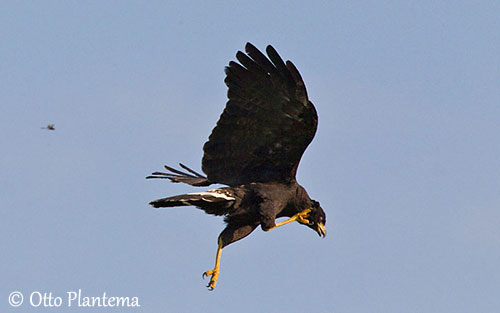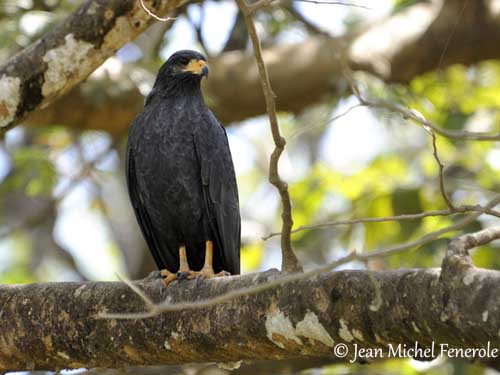
Fr: Buse noire
All: Krabbenbussard
Esp: Busardo-negro Norteño, Aguililla-negra menor, Cangrejero Negro, Gavilán Cangrejero
Ital: Poiana nera comune
Nd: Zwarte Buizerd
Sd: Mindre svartvråk
Photographers:
Jean Michel Fenerole
Photos d’Oiseaux du monde
Steve Garvie
RAINBIRDER Photo galleries
René Lortie
http://rlortie.ca/
Otto Plantema
Trips around the world
Text by Nicole Bouglouan
Sources:
HANDBOOK OF THE BIRDS OF THE WORLD Vol 2 by Josep del Hoyo-Andrew Elliot-Jordi Sargatal - Lynx Edicions - ISBN: 8487334156
HAWKS, EAGLES AND FALCONS OF NORTH AMERICA by Paul A. Johnsgard - Smithsonian Institution Press - ISBN: 1560989467
A GUIDE TO THE BIRDS OF MEXICO AND NORTHERN CENTRAL AMERICA by Steve N. G. Howell, Sophie Webb - Oxford University Press - ISBN: 0198540124
A GUIDE TO THE BIRDS OF COLOMBIA by Steven L. Hilty and William L. Brown - Princeton University Press – ISBN 069108372X
BirdLife International (BirdLife International)
Animal Diversity Web (University of Michigan Museum of Zoology)
Neotropical Birds – Cornell Lab of Ornithology
What Bird-The ultimate Bird Guide (Mitchell Waite)
Wikipedia, the free encyclopaedia
Common Black Hawk
Buteogallus anthracinus
Accipitriformes Order – Accipitridae Family
INTRODUCTION:
The Common Black Hawk belongs to the seventh group of Accipitridae, and is classified in the genus Buteogallus which gathers five species. The Common Black Hawk is very similar to the Mangrove Black Hawk (B. subtilis) and the Great Black Hawk (B. urubitinga). They are medium-sized stocky raptors, with relatively long legs, broad wings and short tail. The long legs are adapted to their usual habitat near water, in mangroves, swamps and tidal flats, but also to their hunting behaviour by walking on the ground for some species.
DESCRIPTION OF THE BIRD:
Biometrics:
Length: 43-52 cm
Wingspan: 122-127 cm
Weight: M: 793 g – F: 1200 g
The adult has black to deep fuscous brown plumage overall, except on the tail which shows a narrow white tip and a broader white band through the middle. The underwing is black with weak paler mottling, and small white markings at base of outermost primaries.
Cere, lores, legs and feet are yellow, although the cere can be white too. The bill is black. The eyes are dark brown.

Both sexes have similar plumage, but female is larger than male.
The immature is dark brown on the upperparts with buffy streaking. The underparts are buff to ochraceous, and heavily streaked brown. The thighs are finely barred. The tail shows several dark and pale bars.
SUBSPECIES AND RANGE:
We can find three subspecies:
B.a. anthracinus (here described) is found in SW and S USA, S through Central America to N Colombia and extreme NW Ecuador. It also occurs E along the Caribbean coast to NW Guyana, Trinidad and St Vincent (Lesser Antilles).
B.a. gundlachii is found on Cuba and I of Pines. This race is smaller and usually browner than nominate, with whitish malar stripe.
B.a. utilensis occurs on Cancun I and Cozumel I, off Yucatan, also on islands in Gulf of Honduras and probably other adjacent islands. This one is intermediate between nominate race and B. subtilis.
HABITAT:
The Common Black Hawk is usually found in lowland areas providing source of water where it can find its favourite preys. This hawk needs trees for nesting and roosting. According to the range, it can be found in coastal areas in Panama, up to 500 metres of elevation in Colombia in tropical and subtropical areas, or in mountain forest on St Vincent.
This species may follow the large rivers into the interior. It frequents dense, mature riparian wooded areas with mesquite, and may occur in hilly desert.
The subspecies B.a. gundlachii frequents mangroves and tidal flats.
In S and C Americas, its presence or absence is related to prey availability.
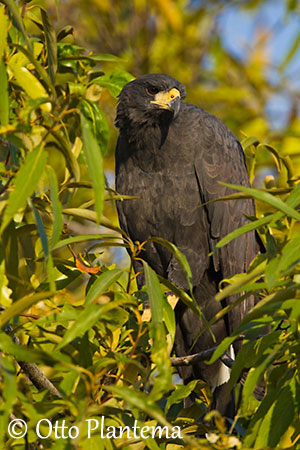
CALLS AND SONGS: SOUNDS BY XENO-CANTO
The Common Black Hawk utters rapid series of ringing whistled notes, usually given while soaring. These calls are quite different from the harsh screams of the Great Black Hawk. This series includes 10-15 shrill whistles, accelerating at the end. It sometimes utters a shorter series “klee klee keer kir”. Short series of slower whistles can alternate with more rapid phrases.
The race “gundlachii” utters repeated sequence of 3 short whistles.

BEHAVIOUR IN THE WILD:
The Common Black Hawk feeds mainly on fish, but the diet may vary, including reptiles, amphibians and land crabs. However, rodents, bats and birds are taken too, but they are a small part of the diet.
The preys depend on the range and availability. Some invertebrates such as grasshoppers and caterpillars can be taken as supplements.
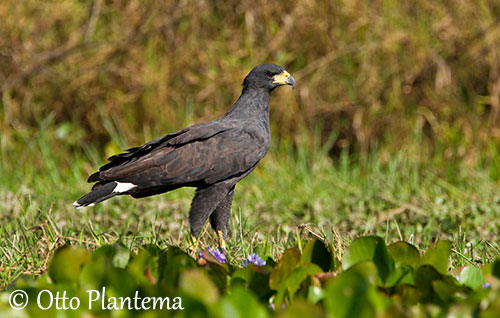
It often hunts from small tree or low perch. It also walks frequently on the ground to catch preys. Both mates often soar together and search for preys, but they also survey an area from higher perch, about 15 metres above the ground. Fish is taken with the talons, like the fish-eagles do.
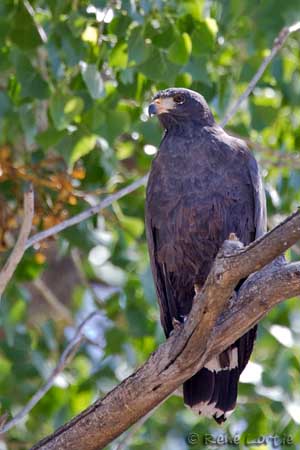
The Common Black Hawk performs flight displays at the beginning of the breeding season. The hawk climbs with slow, exaggerated wingbeats, circling and gliding with dangling legs while calling loudly.
Prior to copulation, the male may perch near the female and mounts her, or it swoops down directly on her back and they copulate, usually at about 15-20 metres from the nest.
The courtship displays start in January in Trinidad and in February in Panama. The migrating northern birds display when they arrive at their breeding sites in early march.
Detailed information is lacking about pair-bonding, territoriality and social behaviour. However, loud and hoarse whistles are reported during the nesting period, fairly similar to those of Nycticorax nycticorax calls.
The Common Black Hawks of the northernmost parts of the range (N Mexico and S USA) leave their breeding ranges for winter, and probably reach southern regions. Other populations are presumed to be sedentary.
It performs undulating aerial displays with alternated climbs and dives. It soars on flattish wings with the tail spread, and alternates glides and strong wingbeats.

REPRODUCTION OF THIS SPECIES:
The Common Black Hawk uses a bulky stick nest, lined with twigs and greenery. Both sexes build the nest in tree, between 5 and 30 metres above the ground, usually in mangrove, in various types of trees.
The female lays 1-3 creamy-white eggs with brownish markings. The incubation lasts 39-40 days, mainly by female but the male takes part too.
At hatching, the chicks have grey down with whiter head and breast. The female usually remains at nest with them, or perches close to it while the male is foraging to provide food. After three weeks, the female starts to forage with the male.
The chicks fledge between 43 and 50 days after hatching. Later, they will be seen soaring with their parents at about 80 days old.
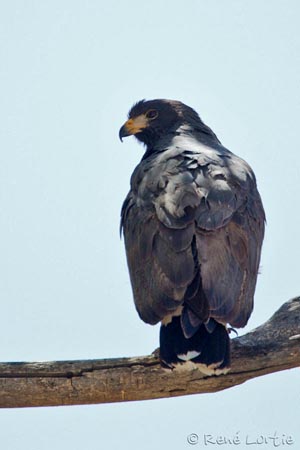
PROTECTION / THREATS / STATUS:
The Common Black Hawk appears relatively common throughout most of the range, with a population of 2 000 000 mature individuals. However, this species exhibits a low reproduction rate, and depends on suitable habitat. It is vulnerable to disturbances.
The Common Black Hawk is not currently threatened, except in Texas where the nesting population was eliminated in the 20th century.
The race “gundlachii” has more restricted range, and is estimated as 10 000/15 000 mature individuals.
